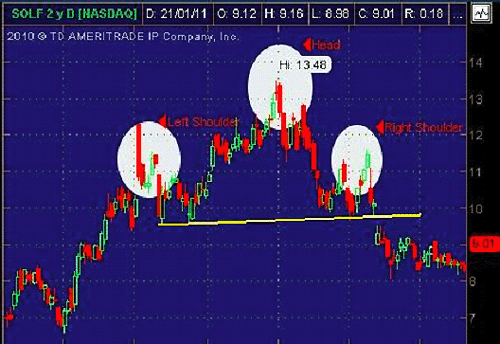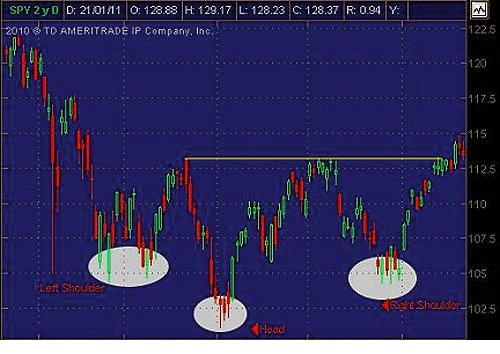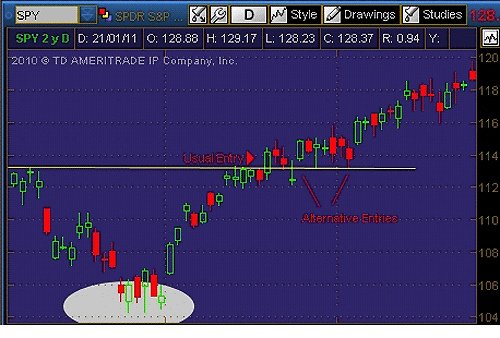The head-and-shoulders chart pattern is a popular and easy-to-spot pattern - once a trader is aware of what they are watching for. The pattern appears on all times frames and can therefore be used by day and swing traders as well as investors. Entry levels, stop levels and price targets make the formation easy to implement as the chart pattern provides important and easy-to-see levels. (Every time an investor talks about getting in low or picking entry and exit points, they are paying homage to these men. Check out The Pioneers Of Technical Analysis.)
What the Pattern Looks Like
First, we'll look at the formation of the head and shoulders pattern and the inverse head and shoulders.
Head-and-Shoulders
- Seen at market tops.
- Formation of the pattern:
- Left shoulder: Price rise followed by a left price peak, followed by a decline.
- Head: Price rise again forming a higher peak.
- Right shoulder: A decline occurs once again, followed by a rise forming the right peak which is lower than the head.
- Formations are rarely perfect, which means there may be some noise between the respective shoulders and head.
 |
Figure 1: SOLF Daily Chart – Head and Shoulders (June 2010-Dec. 2010) |
Source: Think or Swim - TD Ameritrade |
- Seen at market bottoms.
- Formation of the pattern:
- Left shoulder: Price declines and moves higher.
- Head: another Decline occurs to a lower level.
- Right shoulder: Price then moves higher and moves back lower, but not as low as the head.
- Again, formations are rarely perfect. There may be some market noise between the respective shoulders and head.
 |
Figure 2: SPY Daily Chart - Inverse Head and Shoulders (April 2010-Sept. 2010) |
Source: Think or Swim-TD Ameritrade |
Placing the Neckline
The first step is to locate the left shoulder, head and right shoulder on the chart. In the standard head and shoulders pattern (market top), we connect the low after the left shoulder with the low created after the head. This creates our “neckline” - the yellow line on the charts. We’ll discuss the importance of the neckline in the following section. In a reverse head-and-shoulders pattern, we connect the high after the left shoulder with the high formed after the head thus creating our neckline for this pattern.
How to Trade the Pattern
It is very important that traders wait for the pattern to complete. One should not assume that a pattern will develop, or that a partially developed pattern will become complete in the future. Partial or nearly completed patterns should be watched, but no trades should be made until the pattern breaks the neckline. In the head and shoulders we are waiting for price action to move lower than the neckline after the peak of the right shoulder. For the inverse head and shoulder, we wait for price movement above the neckline after the right shoulder is formed.
A trade can be initiated as the pattern completes. Plan the trade beforehand, writing down the entry, stops and profit targets and noting any variables that will change your stop or profit target.
The most common entry is when a breakout occurs - the neckline is broken and a trade is taken. Another entry point requires more patience and comes with the possibility that the move may be missed all together. This method involves waiting for a pullback to the neckline after a breakout has already occurred. This is more conservative in that we can see if the pullback stops and the original breakout direction resumes, but it also means the trade may be missed if the price keeps moving in the breakout direction. Both methods are shown in Figure 3.
 |
Figure 3: SPY Daily Chart – Possible Entry Points (Aug. 2010-Oct. 2010) |
Source: Think or Swim-TD Ameritrade |
Placing Your Stops
In the traditional market top pattern, the stops are placed just above the right shoulder (topping pattern) after the neckline is penetrated. Alternatively the head of the pattern can be used as a stop, but this is likely a much larger risk and thus reduces the reward to risk to ratio of the pattern. In the inverse pattern, the stop is placed just below the right shoulder. Again, the stop can be placed at the head of the pattern, although this does expose the trader to greater risk. In Figure 3, the stop would be placed at 104 (just below right shoulder) once the trade was taken.
Setting Your Profit Targets
The profit target for the pattern is the price difference between the head and low point of either shoulder. This difference is then subtracted from the neckline breakout level (at a market top) to provide a price target to the downside. For a market bottom, the difference is added to the neckline breakout price to provide a price target to the upside.
As SPY is a heavily traded ETF representing the broader market, the profit target for the inverse head and shoulders pattern in Figure 2 would be:
| 113.20 (this is the high after left shoulder) – 101.13 (this is the low of the head) = 12.07 |
This difference is then added to the breakout price (subtracted in the case of a regular head and shoulders pattern). The breakout price is right around 113.25, giving us a profit target of 125.32 (113.25 + 12.07).
Sometimes, investors have to wait a long time - up to several months - between spotting the breakout and reaching the ideal profit target. (Monitoring your trades in real-time can help you anticipate their outcomes. Check out Anticipate Trends To Find Profits.)
Why the Head-and-Shoulders Pattern Works
No pattern is perfect, nor does it work every time. Yet there are several reasons why the chart pattern theoretically works (the market top will be used for this reasoning, but it applies to both):
- As price falls from the market high (head), sellers have begun to enter the market and there is less aggressive buying.
- As the neckline is approached, many people who bought in the final wave higher or bought on the rally in the right shoulder are now proven wrong and facing large losses – it is this large group which now will exit positions driving the price towards the profit target.
- The stop above the right shoulder is logical because the trend has shifted downwards – the right shoulder is a lower high than the head - and therefore the right shoulder is unlikely to be broken until an uptrend resumes.
- The profit target assumes that those who are wrong or purchased the security at a poor time will be forced to exit their positions, thus creating a reversal of similar magnitude to the topping pattern which just occurred.
- The neckline is the point at which many traders are experiencing pain and will be forced to exit positions, thus pushing the price towards the price target.
- Volume can be watched as well. During inverse head and shoulder patterns (market bottoms), we would ideally like the volume to expand as a breakout occurs. This shows increased buying interest that will move price towards the target. Decreasing volume shows lack of interest in the upside move and warrants some skepticism.
The Pitfalls of Trading Head-and-Shoulders
As stated, the pattern is not perfect. Here are some potential problems with trading a head and shoulders pattern:
- You need to find patterns and watch them develop, but you should not trade this strategy until it is completed. So it could mean a long period of waiting.
- It will not work all the time. The stop levels will be hit sometimes.
- The profit target will not always be reached, so traders may wish to fine tune how market variables will affect their exit from the security.
- The pattern is not always tradable. For example, if there is a massive drop on one of the shoulders due to an unpredictable event, then the calculated price targets will likely not be hit.
- Patterns can be subjective. One trader may see a shoulder, where another does not. When trading patterns, define what constitutes a pattern for you beforehand - given the general guidelines above.
Bottom Line
Head and shoulder patterns occur on all times frames, and can be seen visually. While subjective at times, the complete pattern provides entries, stops and profit targets making it easy to implement a trading strategy. The pattern is composed of a left shoulder, head, then followed by a right shoulder. The most common entry point is a breakout of the neckline, with a stop above (market top) or below (market bottom) the right shoulder. The profit target is the difference of the high and low with the pattern added (market bottom) or subtracted (market top) from the breakout price. The system is not perfect, but does provide a method of trading the markets based on logical price movements. (Profit-taking opportunities abound using this lesser-known pattern. Find out how. See Introducing The Bearish Diamond Formation.)
by Cory Mitchell
No comments:
Post a Comment